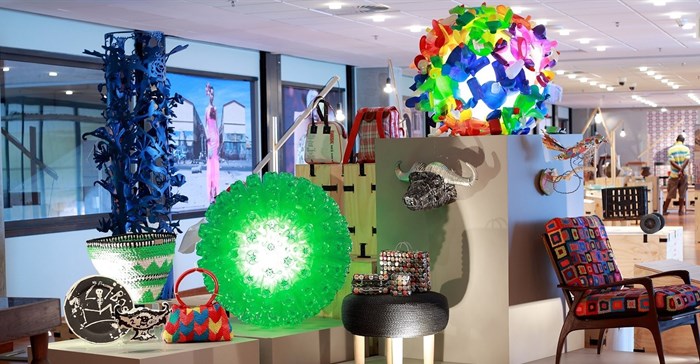





Erica Elk, CCDI executive director, explains that the CCDI was set up in 2001 to support the needs of creative businesses in the Western Cape, and to grow the region’s craft and design sector. A not-for-profit company, the CCDI was jointly initiated by the Western Cape Government and the Cape Peninsula University of Technology (CPUT).

Now, with 15 years of experience in developing the craft and design sector, it’s the only institute of its kind in the country and has developed from a start-up with just two members of staff and a database of 63 craft producers into a well-established institution with 42 members of staff providing support to over 5,500 small creative businesses that provide jobs or income-generating opportunities to an estimated 17,000 people. Now the rest of SA is set to benefit.
In the last financial year alone, the CCDI delivered 140 training workshops, mentored 275 businesses, generated R5.4m in direct trade, ran 2,000 one-on-one sessions in product support and helped 1,848 individuals through 5,789 support activities to member enterprises.
It’s therefore obviously a good idea to be a member of the CCDI, especially it offers a range of creative services to help businesses grow.
Little wonder then that Elk pins her overall highlight to seeing how the sector has grown and matured over the years, at a macro and micro level. She lists the Watershed at the V&A Waterfront as representing significant investment by the private sector in the sector, and reaping the rewards of this by reporting 300% increase in retail trade in its first year. While lots more work to be done to develop marginal areas, such as Langa, Gugulethu and Khayelitsha to drive tourism and local economic development, seeds are being sown and the CCDI will help nurture this with local partners and roleplayers.
But don’t for a minute think this doesn’t apply to you, as the design sector contributes to many other industries and sectors, such as tourism, manufacturing, retail, mining, agriculture, financial, government through communications, spatial, service, systems, and product design. In addition, as the design sector consists of early adopters of ideas, technology, and creative solutions, their value in the economy is immeasurable and their value to society flows deep.
Elk explains just how deep in this exclusive Q&A…
Elk: The CCDI runs a host of open free-to-the-public events from our Creative Exchange, a longstanding monthly industry talk held at our office, to our First Thursday Night Market, on the corner of Barrack and Harrington Streets. These events we run and our involvement in key sector events like festivals happening throughout the year is an important part of the work that the CCDI does to share expertise and knowledge, create opportunities for the creative businesses we work with, and expand the pool of businesses we support in the sector.
Elk: The quality of SA’s products is good and getting better. We’re in a very good place, and on an upward trajectory in terms of developing our local aesthetic and confidence in expressing ourselves. An exciting new trend emerging is the growth in the number of young black designers, particularly in the fashion industry.
What we haven’t got right is developing our capacity to scale up. We hear that some producers are selling designs for manufacture off-shore – which is an easy solution to our challenge of limited local manufacturing capacity and is great for the individual business. But this isn’t the best solution for the growth of our sector and our economy – so we need to figure out how we build our manufacturing capacity locally. It’s great that we have this ‘problem’, because it’s a sign of a growing and maturing sector and shows that demand for our products is starting to outstrip our ability to supply. So this requires new strategies and interventions – some out-of-the-box thinking and creating connections between designers and manufacturers, which we are looking at how we drive.
There are also interesting developments at the intersection of design and technology; and in how the process of design thinking is being used in other sectors of the economy and to address social challenges. This is a new growth trajectory for the sector and designers from a wide range of disciplines are increasingly interested in this area, especially with the Western Cape government’s Better Living Challenge, of which Loeries Ubuntu award-winning Lumkani was again a winner.
Design thinking is gaining greater recognition locally as the key to innovation, which is one of the most important drivers of efficiency, competitiveness and economic growth.
A: We have some very exciting plans afoot that will set us on another 15-year trajectory of growth and development, and create increased opportunities for the sector.
We’re formalising what has been ad hoc and will start working nationally to collaborate with other agencies and organisations in other provinces to share resources, skills and expertise to build the craft and design sector across the country. This includes the creation of three new companies to generate income through selling products and services primarily to the corporate sector: CCDI Capital is a funding and investment vehicle; CCDI Connect is a procurement service to the corporate sector; and CCDI Creative is a workforce development service.
Elk concludes: “Anyone who proudly described themselves as a designer of sorts has made a committed life-choice and lifestyle choice with design as their chosen avenue of expression; and a design environment provides the stimulation and inspiration for creative innovation. The sector therefore displays a remarkable resilience in the face of adverse economic circumstances. “
All the more reason for design optimism. For more on the CCDI, visit their website or follow them on Twitter and Facebook.
